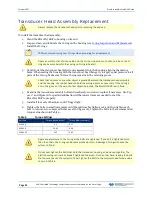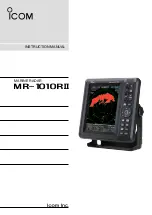
October 2017
RiverPro and RioPro ADCP Guide
Page 50
EAR-Controlled Technology Subject to Restrictions Contained on the Cover Page.
4. Remove all four transducer head bolts from the transducer head.
5. Set the transducer assembly (transducer face down) on a soft pad. Carefully lift the housing as-
sembly straight up and away from the transducer. Use care; the plastic mating surfaces scratch
easily. Do not damage the mating surfaces.
6. Clean the O-ring mating surfaces with a soft, lint-free cloth. Inspect the surfaces for damage (see
O-ring Inspection and Replacement
).
7. When ready to re-assemble the RiverPro/RioPro, see
RiverPro/RioPro Re-assembly
To replace the end-cap and transducer head, proceed as follows. Use Figure 17 and Figure 18 for parts
identification.
•
Make sure all printed circuit boards, spacers, cables, and screws have been installed.
•
Install one fresh bag of desiccant just before closing the RiverPro/RioPro (see
Desiccant Bags
).
Desiccant Bags
Desiccant bags are used to dehumidify the housing interior. Desiccant is essential in deployments with
plastic housings. Remember that desiccant rapidly absorbs moisture from normal room air. Replace the
desiccant bag whenever the RiverPro/RioPro system is opened.
Do not open the desiccant bag. Contact with the silica gel can cause nose, throat, and skin
irritation. Do not puncture or tear the desiccant bag. Do not use desiccant bags that are torn
or open.
Desiccant bags are shipped in an airtight aluminum bag to ensure maximum effectiveness.
There is a moisture indicator inside the bag. If the moisture indicator is pink, do not use the
desiccant bag until it has been dried. TRDI recommends replacing the desiccant bag just
before the installing the end-cap.
To replace the desiccant:
1. Remove the end-cap (see
End-Cap Removal Procedures
).
2. Remove the new desiccant bag from the airtight aluminum bag.
3. Remove the old desiccant bag and install a new one. Place the desiccant bag as shown in Figure 17
and Figure 18.
Place the desiccant carefully such that when end-cap is attached, no electronic components
are damaged.
4. Install the end-cap (see
End-cap Replacement
).
















































